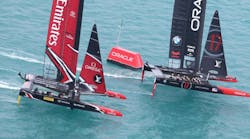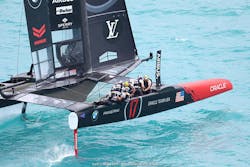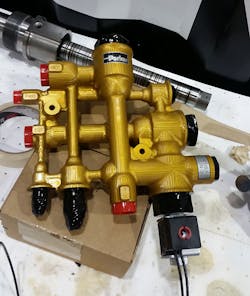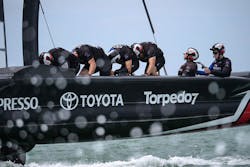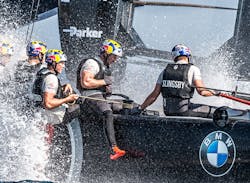After the 35th America’s Cup is over, possibly today, as Emirates New Zealand has a commanding 6-1 lead, Oracle Team USA member Stuart Meurer will return to sunny Southern California to design jets’ flight control systems to help them break the speed of sound. Sometimes the trained aerobatic pilot may find himself again flying upside down pulling 6 g.
For the last few years, Meurer, a project manager for Parker Hannifin, has been grounded in Bermuda (which ain’t such a bad place to be grounded). Loaned out to Team USA by the motion control company, Meurer has been charged with overseeing the overhaul of the racing yacht’s motion control system.
That may not seem all that difficult if you picture the regatta as two sailboats gently skimming above the turquoise water of the island nation’s Great Sound, occasionally trimming their jibs to catch more wind. That may have worked in 1851, when the New York Yacht Club’s schooner won the first of these contests.
“The use of lines, ropes, hand winches is pretty much gone,” Meurer says. “The motion of every control surface, whether it's the daggerboards, the rudders the wing twist, the jib, in every direction is hydraulic actuation.”
And unlike the old wooden ships of the Victorian era, this 50-ft. catamaran can fly. Jutting under both canoe-like carbon fiber hulls, a hydrofoil looms waits under the surface until the moment is right for a miraculous feat of physics and engineering.
“When you get out on the actual sailboat and you get laid down on the trampoline, once you get up to 7 mph of wind, that's when it smoothly transitions up into the air and you're kind of floating,” says Meurer, speaking of the time he went on one of the very similar practice boats, the AC45. He describes the quiet calm felt while gliding above the surf as “just kind of nirvana.”
Because of this level of peak engineering, the design and performance expectations of this highly sophisticated craft are comparable to a Formula 1 car. Both surf and turf racers require the upper limit of humanity’s cleverness to squeeze speed and precision. Every control surface has to be in the right position to get maximum lift and speed, only possible with the latest in flight control technology.
“The process is pretty different due to the schedule restraints, but we're doing aerospace design,” Meurer says. “The analysis portion of it where we're looking at the operating load range, the envelope, the loads, the speeds, safety margins — all of that we do the same here as in aerospace.”
The components themselves have to be able to fly and get wet, as a catamaran whipping around at 54 mph is subject to capsizing, all the components need to stand up to a saltwater bath every now and again, and were designed to be submerged.
Utilizing the Intellinder absolute position sensor, which is embedded in the hydraulic system to keep out harmful elements such as corrosion or water, also gives an edge.
Manufacturing the parts is also not much different, using CAD software to design the manifolds and CNC machine to make them, although hydraulic efficiency is given preference over weight.
This is so important because, as per the cup rule, all the hydraulic power has to be manually generated. Four of the six members has a grinder they hand crank to generate up to about 300 W, about enough to make a small pot of coffee or toast bread. The race is 20 to 25 minutes, and wasted energy is simply not a luxury these yachts can afford.
Emirates New Zealand chose to pedal, setting up their grinders like stationary bikes, and they currently have a 6-1 lead on Team USA, with the race resuming June 24. During this time, the crew and support staff have been going over strategy and fine tuning the catamaran in a secretive hanger in the Royal Navy Dockyard.
Meuer says the foot pedaling vs. hand cranking isn’t the reason the Kiwis have taken a commanding lead. He admits that leg power of course generates more power, but other factors, such as crew stamina and keeping a low aerodynamic profile were also taken into account. The main factor is New Zealand has so far maximized the steering in “light air.”
“It is more of a strategic decision on what wind conditions you want to design your boards for and they happen to have gotten it right for last weekend,” he says.
So for now, the crew and support team are working around the clock to make any final changes to give them a chance to comeback, as they did in 2013, winning the last eight races against New Zealand to win 9-8.
Win or lose, Parker’s goal was always to showcase how they can customize motion control solutions for any environment and any need, in a way people can actually visualize. You can’t see the parts that make a jet fly so smoothly, but you can see a giant sail rotating on a clear blue sea.
The real point is to get the message out that Parker, which is celebrating its centennial, doesn’t just create valves, sensors and pneumatics to control motion. They engineer solutions.
Meurer has already noticed it being much easier to explain what he does for to his own company, which has more than two dozen divisions.
“When I show people the pictures of the AC50, people are saying, ‘Oh my God, we can make those fly. What can we do for everybody else?’” he says. “I think we can solve any problem that is out there.”










